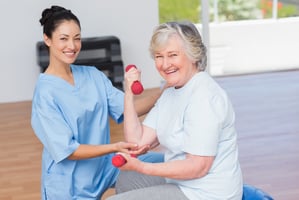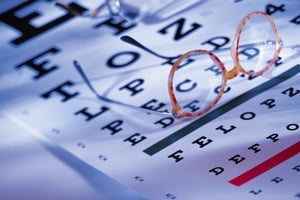At VNA of Ohio, our rehabilitation therapy team includes physical therapists, occupational...
Post-Stroke Rehab: Caring for a Loved One After a Stroke
A stroke occurs when the blood flow in a patient’s brain is disrupted because of a blood clot or broken blood vessel. Depending on the location of the clot or bleed in the brain, the effects can range from slight vision loss to total paralysis.
As a result, every stroke patient requires different expertise and resources for their care and rehabilitation. Some stroke patients are left requiring full-time care in a skilled nursing care facility. But many others return home following a stay in the hospital or in-patient rehabilitation facility. In order to complete the recovery process, those patients may need to continue their rehab work at home.
When that time comes, Visiting Nurse Association of Ohio sends a nurse to the patient’s home to assess the needs and determines a care plan designed to restore the patient to the fullest level of function and independence.
“Unlike some patients, like those who’ve had surgery or who have some other diagnoses, you can’t expect that stroke patients will have the same set of problems,” Wendy Fishman, director of rehabilitation therapies, said.
Post-Stroke Rehab: Some Common Effects Stroke Patients May Experience Include:
- Speech impairment
- Hearing loss
- Vision loss
- Varying degrees of paralysis
- Difficulty swallowing
- Pain
As part of the assessment, a VNA of Ohio home healthcare nurse will determine what equipment and devices might improve the patients’ safety and comfort or help with care giving. Items suggested for a stroke patient’s home care might include a hospital bed, lifts, hold bars, raised toilet seats or equipment to allow for bedside toileting.
The assessment also will include a compilation of services that will be included in the care plan. Physical therapists, occupational therapists, social workers and home-health aides may provide those services.
Amy Silbaugh, manager of mental health services, states each patient’s rehab plan sets a realistic goal. Sometimes the goal is complete recovery of full function. Other times, the goal is to bring the patient to the point where their family can care for them safely. That might mean improving their ability to roll over in bed, or to stand with assistance to help with transfers.
“We have to make sure that the family and the home is set up so they have the resources and can handle caring for the patients,” Silbaugh said.
She said it isn’t always immediately clear what level of recovery will be achievable following a stroke. Sometimes, VNA of Ohio nurses recognize that what at first may have seemed to be a safe and manageable situation at home is not sustainable given the patient’s condition.
“Safety at home is the most important thing,” Silbaugh said. “But if appropriate, and the family can handle care giving, there is a lot that can be good about being at home rather than in an institutional environment.”
Call VNA of Ohio Today
Learn more about VNA of Ohio rehabilitation therapy services, or call us today at 1-877-698-6264.



